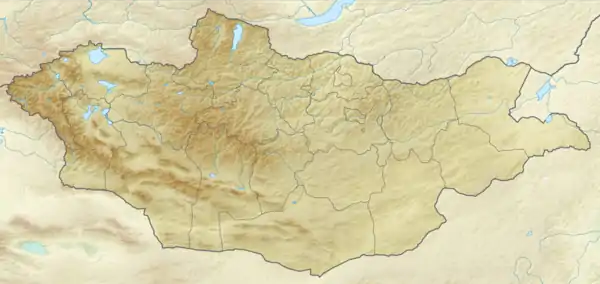Bakhar Formation
The Bakhar Formation (Russian: Bakhar Svita) is a geological formation in Mongolia whose strata date back to the Aalenian to Bathonian stages of the Middle Jurassic, comprising claystones deposited in a lacustrine environment.[1]
| Bakhar Formation Stratigraphic range: Aalenian-Bathonian ~174–166 Ma | |
|---|---|
| Type | Geological formation |
| Lithology | |
| Primary | Claystone |
| Other | Coal |
| Location | |
| Coordinates | 44.9°N 100.9°E |
| Approximate paleocoordinates | 48.1°N 105.2°E |
| Country | |
| Extent | North Molasse Basin |
 Bakhar Formation (Mongolia) | |
Fossil content
An insect, Platyperla propera,[2] fish (Palaeonisciformes) and pterosaur remains of the family Anurognathidae have been recovered from the formation.[3][4] The formation has also provided many fossil flora in its coal layers, known as the Tsagan-Ovoo Flora containing 32 megafossil plant taxa belonging to horsetails, ferns, cycadaleans, ginkgoaleans, leptostrobaleans, conifers and gymnosperms. Three new species were named; Ginkgo badamgaravii, Pseudotorellia gobiense and P. mongolica.[5]
See also
- List of pterosaur-bearing stratigraphic units
- Balabansai Formation, contemporaneous fossiliferous formation of Central Asia
- Itat Formation, contemporaneous fossiliferous formation of Russia
- Ukureyskaya Formation, contemporaneous fossiliferous formation of Russia
- Tiaojishan Formation, contemporaneous fossiliferous formation of China
References
- Bakhar Formation at Fossilworks.org
- Sinitshenkova, 1987
- Bakhurina & Unwin, 1995
- Barret et al., 2008
- Kostina et al., 2015
Bibliography
- Kostina, Elena I.; Alexei B. Herman, and Tatiana M. Kodrul. 2015. Early Middle Jurassic (possibly Aalenian) Tsagan-Ovoo Flora of Central Mongolia. Review of Palaeobotany and Palynology 220. 44–68. Accessed 2020-07-09.
- Barrett, P.M.; R.J. Butler; N.P. Edwards, and A.R. Milner. 2008. Pterosaur distribution in time and space: an atlas in Flugsaurier: Pterosaur papers in honour of Peter Wellnhofer. Zitteliana B 28. 61–107.
- Bakhurina, N.N., and D.M. Unwin. 1995. A survey of pterosaurs from the Jurassic and Cretaceous of the former Soviet Union and Mongolia. Historical Biology 10. 197–245.
- Sinitshenkova, N.D. 1987. Istopicheskoe razvitie vesiyanok. Akademiya Nauk SSSR, Trudy Paleontologicheskogo Instituta 221. 1–142.
This article is issued from Wikipedia. The text is licensed under Creative Commons - Attribution - Sharealike. Additional terms may apply for the media files.